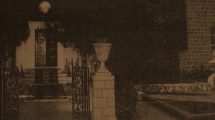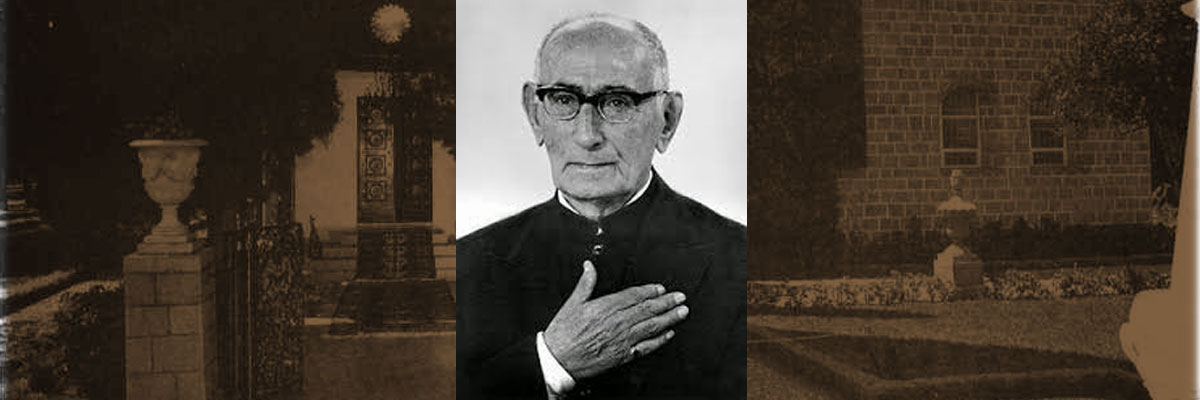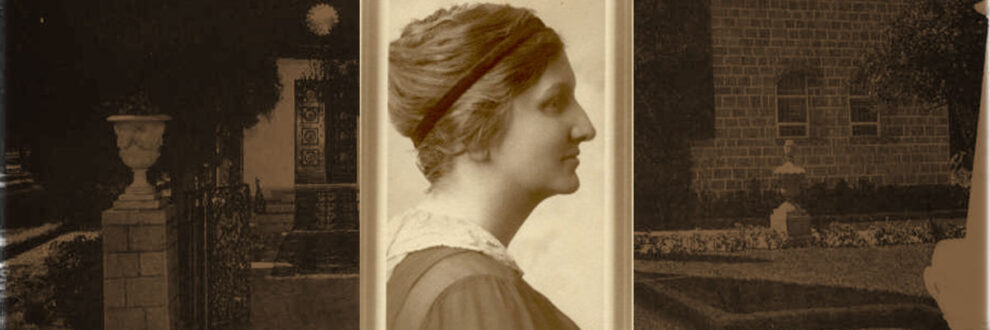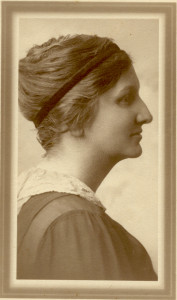
Agnes Baldwin Alexander
Born: July 21, 1875
Death: January 1, 1971
Place of Birth: Honolulu, Hawai’i
Location of Death: Honolulu, Hawai’i
Burial Location: Mission Cemetery, Honolulu, Hawai’i
In the Kitab-i-Iqan Bahá’u’lláh makes the statement that were anyone to reach the station of the True Seeker, he would inhale at a distance of a thousand leagues the, fragrance of God, and would perceive the resplendent morn of a divine Guidance rising above the dayspring of all things. Many more than a thousand leagues away from ‘Akka, the abode of the Blessed Perfection, a little girl in far-off Hawai’i dreamed of serving Christ, but in her own words:
“His life seemed far away from me, and I always felt that something was lacking, that I had never been reborn.”
If ever a child was blessed with a brilliant and noble heritage it was this little girl, Agnes Baldwin Alexander, destined herself to become a star even more illustrious than any of her famous forebears. Agnes’s grandparents on her mother’s side were the Rev. and Mrs. Dwight Baldwin who sailed from New Bedford, Massachusetts, with the fourth company or”missionaries sent by the American Board of Missions in 1831. “My dear mother,” Agnes would say, “was born in a grass house.” On her father’s side, her grandparents were the Rev. and Mrs. William Patterson Alexander, who arrived in the Hawaiian Islands in 1832 after a voyage of 186 days. One need only read James Michener’s Hawai’i to realize what hardships these newlywedded servants of Christ were forced to endure on the decrepit, overloaded whaling ship of that era.
Though of delicate physique and gentle and timid by nature, Agnes was nevertheless to fall full heir to the courage of her ancestors. From childhood there was a special quality about her which her father recognized as unique; and possibly this insight led to his sending her abroad on a trip which was to change her whole life and bring to the Hawaiian Islands the light of a new Faith.
Agnes was born in Honolulu, on July 21, 1875. But her real life, as she saw it, did not begin until she was reborn as a follower of Bahá’u’lláh.
“Until one has been awakened by the Breath of the Holy Spirit, one is asleep,” she said, “for the only reality is that of the spirit. For twenty-five years I was asleep.”
In 1900 it was most unusual for a young lady of Agnes’s gentle birth, and of her then timid nature, to travel alone across oceans and continents, and indeed her father had not intended it that way when he suggested that she accompany some friends who were going to Europe. But as Agnes said later, her father unwittingly guided her to the light of a New Day, and God prepared her for her future role in His service when she was unexpectedly forced to cross the Atlantic alone. She was en route to Rome when suddenly she felt that she was nearing her goal.
Indeed she was, though as yet she could not analyse such an intuition.
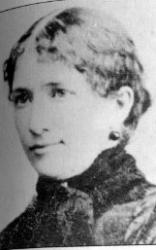
The story of her meeting with Mrs. Charlotte Dixon and her two daughters in a pension in Rome is one which Agnes never tired of telling, nor anyone ever tire of hearing: one can see Agnes surrounded by friends with awed faces listening with rapt attention as she recounted the tale of her strange fascination for an unknown woman and her daughters. Shy as she was, she nevertheless stared at them until she was ashamed, for they exuded a radiant happiness. At last, unable any longer to bear the suspense she actually accosted Mrs. Dixon and asked to know the secret of their joy.
Mrs. Dixon had just returned to Europe after a pilgrimage to the Holy Land, but that evening as she talked to Agnes she made no allusion to the advent of a Promised One, What exactly she did say, we do not now know, but her words touched Agnes’s heart and caused the tears to flow. In those early days the Message was seldom given directly; however, Mrs. Dixon gave Agnes a handwritten copy of a Bahá’í prayer. In Agnes’s words it ‘answered all the longings” of her heart.
Three days elapsed before Agnes discovered the truth. On the evening of the third day after meeting Mrs. Dixon, she retired to her room, but was unable to sleep; and then, in what she described as neither a dream nor a vision, she became overwhelmingly aware that Christ had returned to earth. In the morning upon encountering Mrs. Dixon she joyously exclaimed ‘Christ is on this earth!” Mrs. Dixon replied, “Yes, I can see by your face that you know it.”
Agnes was to say later, when mass teaching became widespread, that immediate acceptance of the Bahá’í Message was not a mystery to her; that her own instantaneous recognition was a “gift” to her from God. Without books, without being taught, she had recognized her Lord. Just three shining faces in a Roman pension, a little handwritten prayer, and the true seeker had found her spiritual home.
As with many other Bahá’ís, Agnes’s first test came as a result of over-enthusiasm. One Sunday morning after attending church with some relatives she approached the pastor, certain that he would be astounded and grateful to know of Christ’s return. He, however, drew her into his study and proceeded to enlighten her from the Bible as to her “folly”. The timid young lady, slim and delicate with golden hair and blue eyes, appeared to be thoroughly worsted, for she could not answer. Though from childhood she and her family had prayed and read the Bible together, she had never really understood the Holy Book. But here that extraordinary steadfastness, that absolute and unwavering certitude which was to characterize her forevermore, came into play. Agnes knew in her innermost being that Bahá’u’lláh was the Promised One. Accordingly, she bought herself a Bible and for the next three months immersed herself in its contents, becoming delighted and exhilarated as proof after proof of the New Revelation unfolded themselves to her eyes. She still had the one prayer that Mrs. Dixon had given her and the later gift of a copy of Hidden Words. Now she yearned to meet and talk with others who shared her beliefs and her joy. Mrs. Dixon had also given her some addresses of other Bahá’ís. One of these, the nearest, was rue de Bac in Paris. Agnes wrote, asking for more information about her wonderful new-found Faith. She was in Milan when she received a loving letter of welcome from May Ellis Bolles, later to become May Maxwell, wife of the Hand of the Cause William Sutherland Maxwell, and mother of Amatu’l-Baha Ruhiyyih Khanum. Agnes readied herself and set out alone for that enchanted spot where so many of the early French, English and American believers were wont to gather in Paris. There, too, she met Mirza Abu’l-Fadl, that gentle, humble and erudite Persian scholar who was sent by ‘Abdu’l-Bahá to Europe and to America to deepen the knowledge of the friends.
One of the most memorable merriment’s in her entire life was the meeting with May Ellis Bolles, author of that irresistibly beautiful letter which had drawn her to Paris. Though May herself was but a young girl at the time, she was to Agnes, as to many others, a “spiritual mother”. The love she showered upon her “little girl”, her “tender little bird”, was, as described by ‘Abdu’l-Bahá, “divine”. As Agnes sailed away from Europe, May wrote that her tender little bird had flown the nest of its mother and was now to become a divine bird seeking “her eternal nest in His Bosom”.
One of the most interesting things about Agnes was her complete submission to the Will of God. Anyone who knew her would soon become aware of her complete reliance on what she called her “guidance” and her unqualified obedience to it once she had prayed for and received it. She was so fully confident in the outpouring of guidance that would come as a result of earnest prayer, that she never worried about the consequences of following it, never wavered in the face of opposition to it, never questioned or doubted or rebelled against it. Many who tried beforehand to get a decisive answer from Agnes would be frustrated by her reply, “If it is God’s plan.” But the moment she received what she felt was guidance in answer to her prayer, the action was decisive. All through her life Agnes’s sensitivity to the Divine Will was to be confirmed by messages or cables from both the Master and the beloved Guardian; it may have seemed uncanny to others, but to Agnes it was routine.
Agnes had made her declaration of belief on November 26, 1908, and had written her letter of acceptance to ‘Abdu’l-Bahá. Now, seven months later in Paris she fell that the time had come to return to her homeland and proclaim the Faith to the people of the Hawaiian Islands. Her belongings were already packed and she was to leave for London the next morning when a messenger arrived with a Tablet for her from the Master in which He admonished her to be like a divine bird, return to Hawai’i spread the wings of sanctity over the island, warble melodies in praise of God, gladden thereby the Supreme Concourse, cause seeking souls to be attracted as moths to a lighted lamp, and be the means of making Hawai’i illumined by the Light of God.
Agnes arrived in Honolulu on December 26, 1901, the first Bahá’í to set foot on Hawaiian soil. Two generations after the Baldwins and Alexanders arose to establish Christianity in what were then known as the Sandwich Isles, their descendant carried to those shores and firmly planted the banner of Bahá’u’lláh. What poignant thoughts must have stirred within her!
There was such a great difference in Agnes’s general demeanor that her father said the trip had been her “salvation”, and though word had gone round that she had taken up some “weird cult,” her sister said that if it made Agnes happy it must have some value. In Paris, when someone had asked whether Agnes was a Bahá’í, another had simply said, “Look at her face!” But the change in her did not impel any of her immediate family to investigate the source of her happiness. Agnes realized that she would have to demonstrate in her life the power of the Faith to bring happiness and certitude to seeking souls.
For twelve years Agnes remained in Hawai’i. In her published memoirs, Personal Recollections of a Bahá’í Life in the Hawaiian Islands, she describes in detail the progress made in those early years, relating the story of Clarence Hobron Smith, another scion of missionary families of Hawai’i who was the second from the Islands to accept Bahá’u’lláh; of Elizabeth Muther, the famous “Uttie” of Loulie Mathew’s Not Every Sea Hath Pearls; of Dr. George Augur, one of ‘Abdu’l-Bahá’s nineteen disciples, and Mrs. Augur, both of whom were among the first believers in Hawai’i and also among the first to take the Faith to Japan; and of Kanichi Yamamoto, the first Japanese in the world to accept the Faith.
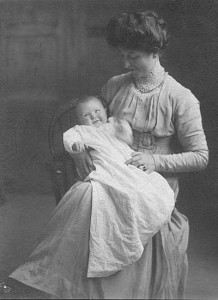 During this period, obeying as usual the voice of inspiration, Agnes had started to make a study of Japan and its culture. With many Japanese living in the Islands it was perhaps not unusual that one with an active inquiring mind should begin such a study, but Agnes felt it was another step preparing her for her role in life. In the spring of 1913 both her beloved parents passed away, her sister sailed for California, and the loving, close-knit family unity was at an end. Agnes was alone. Now she decided that it was time to teach the Faith in other parts of the world, but first she would visit her “spiritual mother” in Montreal. May Bolles was now May Maxwell, and Agnes spent a blissful month at the Maxwell home before going on to spend the winter in New York. In that period she received a Tablet from ‘Abdu’l-Baha encouraging her to travel to Japan and promising an outpouring of divine confirmations. The Tablet was dated October 13, 1913, and had been written just as Agnes was leaving the Hawaiian Islands. Now she knew why she had been studying the culture of Japan.
During this period, obeying as usual the voice of inspiration, Agnes had started to make a study of Japan and its culture. With many Japanese living in the Islands it was perhaps not unusual that one with an active inquiring mind should begin such a study, but Agnes felt it was another step preparing her for her role in life. In the spring of 1913 both her beloved parents passed away, her sister sailed for California, and the loving, close-knit family unity was at an end. Agnes was alone. Now she decided that it was time to teach the Faith in other parts of the world, but first she would visit her “spiritual mother” in Montreal. May Bolles was now May Maxwell, and Agnes spent a blissful month at the Maxwell home before going on to spend the winter in New York. In that period she received a Tablet from ‘Abdu’l-Baha encouraging her to travel to Japan and promising an outpouring of divine confirmations. The Tablet was dated October 13, 1913, and had been written just as Agnes was leaving the Hawaiian Islands. Now she knew why she had been studying the culture of Japan.
She planned to journey to Japan by way of Italy where she had relatives, and hoped to visit the Holy Land en route to the orient, but she was delayed in Switzerland by the outbreak of World War I. In August, 1914, another Tablet from the Master reached her urging her to proceed directly to Japan, thence to India, and to the Holy Land, but making clear that the choice must be hers. It is not difficult to imagine how much Agnes longed to meet the Object of her devotion. Ever since those first wonderful days when the pilgrims from ‘Akka returned to Paris filled with an overflowing love for the Master she had realized that no spot on earth was so like heaven. But totally in keeping with her characteristic unquestioning obedience to His slightest wish, Agnes went directly to Japan. As though protected by guardian angels she sailed safely through the perilous waters where so many other vessels had been bombed and sunk, arriving in Japan in 1914. For the next twenty-three years, although she made many trips home to Hawai’i and to other parts of the Far East,
Agnes made her base in Japan. ‘Abdu’l-Bahá’s appreciation of Agnes’s exemplary service is contained in His Tablets of the Divine Plan, written about two years after her arrival in Japan. He wrote in the Tablet dated April 11, 1916:
Consider ye, that Miss Agnes Alexander, the daughter of the Kingdom, the beloved maid-servant of the Blessed Perfection, travelled alone to Hawai’i . . . and now she is gaining spiritual victories in Japan! Reflect ye how this daughter was confirmed in the Hawaiian Islands. She became the cause of the guidance of a gathering of people. (p.13)
The Tablet contains a further reference to Agnes-the words cited at the opening of this memoir.
In 1921, Agnes spent one month in Korea; she was the first Bahá’í to teach the Faith in that country. She wrote of that period:
“During the month spent in Seoul, God’s power had been triumphant. All doors had been opened. Japanese and Koreans, both Buddhist and Christians, had heard the Bahá’í Message and were now free to search themselves. It could not be said they had been forgotten in God’s great plan for the New Day.”
Through Agnes, many of the young Koreans were inspired to write to ‘Abdu’l-Bahá brief but very sincere expressions of appreciation for the Faith. These she sent to the Master on September 19, 1921, on her return to Tokyo. The answer which He penned to those “heavenly sons” came in February of 1922, more than two months after His passing. Agnes was never to see her Lord on this plane of existence.
 In 1924, Agnes accompanied Martha Root to China where they spoke of the Bahá’í Faith to Sun Yat Sen, the “George Washington of China”, and presented him with two books. While they were in China these two remarkable ladies contacted many people of prominence and spoke at a boys school near Peking.
In 1924, Agnes accompanied Martha Root to China where they spoke of the Bahá’í Faith to Sun Yat Sen, the “George Washington of China”, and presented him with two books. While they were in China these two remarkable ladies contacted many people of prominence and spoke at a boys school near Peking.
In the course of her travels, Agnes visited Taiwan, Hong Kong, the Philippines, the United States, Canada and Europe. She proclaimed the Faith widely on these trips among people of capacity and prestige, and she often used her knowledge of Esperanto to make contacts. She attended conferences on religion, meetings of such organizations as the Institute of Pacific Relations, gave talks at schools, universities, branches of the Young Men’s Christian Association, and was a genius at obtaining publicity for the Faith in the media of mass communication.
While on one of her excursions out of Japan in 1927 she received a letter from Dr. Shiroshi, Dean of Tokyo Imperial University, which reflects the attitude of the Japanese toward this great lady: “As our steamer nears Yokohama, Fuji San is in sight. This is the symbol of our welcome to you! Come to Japan.”
On January 10, 1928, in obedience to an appeal from Shoghi Effendi, she again set sail for Japan. The Guardian wrote: “I long to hear of your determination to return to Japan and pick up the thread of your unsparing efforts and activities for the promotion of the Cause of God. I feel that your destiny lies in that far off and promising country where your noble and pioneer services future generations will befittingly glorify and thankfully remember. May the Beloved remove every obstacle from your path and enable you to resume your active work in that land.”
In 1937, Agnes again left Japan, this time to attain her heart’s desire. She was permitted to make her pilgrimage to the Holy Land, at long last to meet her beloved Shoghi Effendi. To him she tendered that same love and devotion she had previously lavished upon his Grandfather; and he, on his part, appreciated her unceasing labors in the path of God no less than had ‘Abdu’l-Bahá.
The active role of Japan in World War II prevented her return to that country until 1950. Chronologically, Agnes was now growing old. She had already served the Faith for fifty years, yet she was as enthusiastic as ever, possessing a childlike quality of innocence and delight that seemed at times as though it should beat variance with those other qualities which enabled her to be the “founder” of a spiritual “empire”. At fifty-four years of age she had climbed Mount Fuji with a band of Buddhist pilgrims; at eighty-five, on one of her jaunts to the Philippines, she accompanied Jack Davis to the mountains of Luzon where she had to ride for two hours in a jeep bumping along corrugated roads and then ford a stream. Three times over the years she went from cell to cell in the National Prison of Manila, teaching and giving solace to hundreds of prisoners, even those in murderers’ row. Her reason? Because Bahá’u’lláh had been a prisoner.
I first heard from Agnes shortly after we were both appointed to the Auxiliary Board for Asia in 1954. To me, as to other pioneers in the area, she sent loving little notes on flowered paper and often enclosed excerpts from the letters of famous long-gone Bahá’ís, or quotations from the Tablets of ‘Abdu’l-Baha and letters of the Guardian. Her notes expressed her perfectly, for she was forever saying that one must never worry, but must always trust in God and then everything would turn out right. In one of her letters she commented on the joy she found in serving the beloved Guardian under the loving guidance of the Hands of the Cause in Asia, not realizing that she would herself be elevated to the rank of Hand of the Cause on March 27, 1957. With typical modesty, she wrote, in a letter to the Bahá’ís of the Pacific: “As you probably know, the beloved Guardian in one of his cables, gave me the assignment, after the passing of George Townshend:
AGNES ALEXANDER DISTINGUISHED PIONEER FAITH ELEVATED RANK HAND CAUSE CONFIDEN’T APPOINTMENT WILL SPIRITUALLY REINFORCE TEACHING CAMPAIGN NORTH SOUTH HEART PACIFIC OCEAN.
I have only quoted this that you might know the responsibility that our beloved Guardian has given me and that I may have your prayers that as one soul in many bodies we may all work for the one great purpose in life.”
Agnes received approximately one hundred letters from Shoghi Effendi. In one of them, written during the early years of the Guardianship, he asked her to deepen the understanding of the friends in America in relation to the Covenant. She went from centre to centre, and also to Geysrrville Summer School, stressing the Covenant and The Will and Testament of ‘Abdu’l-Bahá. Thus she was responsible for helping many to bridge the period of transition from the Heroic Age to the Formative Age. Her total dedication was given successively to ‘Abdu’l-Baha, Shoghi Effendi and the Universal House of Justice.
Like the waves of the sea, Agnes was always in motion. Typical of many of her letters to the friends is the following: “In January I had the great bounty to accompany our beloved Bahá’ís, Mr. and Mrs. Torii, to the Island of Shikoku where as yet no Bahá’í had been.
Mr. Torii is visiting the schools for the blind and also blind associations of Japan . . . Everywhere I was permitted to speak of our glorious Faith. It was a wonderful week spent on that island! Returning, I came to Hiroshima where last year I was twice. Here I will have been a month when I return to Kyoto in a few days. It has all been glorious and nowhere has there been prejudice shown . . . I feel an especial love for these people. . . Our beloved Guardian wrote that the people of this city who had suffered so cruelly had a right to hear of the teachings of Bahá’u’lláh for peace and brotherhood, so you can imagine 1 feel a deep interest and love here.”
 Not very long after Agnes’s return to Tokyo in 1950 she moved from Tokyo to Kyoto. Always modest and unassuming, she lived at first in a tiny room, then moved to an almost equally tiny apartment, She cooked and served meals to her guests in a kitchen no larger than a closet, and often on trips to Tokyo would astonish visitors to her room by opening up a large suitcase filled with pots, pans, dishes and a hotplate and proceeding to cook them a meal. She had no financial worries, but she expended her resources on the Faith and others; on herself, she expended as little as possible. No matter how far afield she travelled, Hawai’i was always “home”. She loved the Islands and the people and was thrilled when told by the beloved Guardian, at the height of the mass teaching successes in Africa: that now was the time for the brown race to outstrip the black.
Not very long after Agnes’s return to Tokyo in 1950 she moved from Tokyo to Kyoto. Always modest and unassuming, she lived at first in a tiny room, then moved to an almost equally tiny apartment, She cooked and served meals to her guests in a kitchen no larger than a closet, and often on trips to Tokyo would astonish visitors to her room by opening up a large suitcase filled with pots, pans, dishes and a hotplate and proceeding to cook them a meal. She had no financial worries, but she expended her resources on the Faith and others; on herself, she expended as little as possible. No matter how far afield she travelled, Hawai’i was always “home”. She loved the Islands and the people and was thrilled when told by the beloved Guardian, at the height of the mass teaching successes in Africa: that now was the time for the brown race to outstrip the black.
When the National Spiritual Assembly of the Hawaiian Islands was formed in 1964, Agnes attended that first convention as the representative of the Universal House of Justice. Exciting as the event was to all those present, there was none more proud and happy, none who could appreciate the miracle of that moment more fully than that devoted servant who, sixty-two years before, had brought back to her homeland the precious gift of a new Light; arid who had, letter by letter, kept her up with that land. She remembered ‘Abdu’l-Bahá’s prophecies concerning Japan and cherished that first letter written by the young Guardian to the Japanese Bahá’ís, dated January 26, 1922: “Despondent and sorrowful though I be in these darksome days? yet whenever I call to mind the hopes of our departed Master so confidently reposed in the friends in that Far-Eastern land, hope revives within me and drives away the gloom of His bereavement . . . I recall so vividly the radiant joy that transfigured His Face whenever I opened before Him your supplications as well as those of Miss Agnes Alexander. What promises he gave us all regarding the future of the Cause in that land at the close of almost every supplication I read to Him! Let me state . . . the most emphatic, the most inspiring of them all. These are His very words, that still keep ringing in my ears: ‘Japan will turn ablaze! Japan is endowed with a most remarkable capacity for the spread of the Cause of God! . . .’ On another occasion-‘how vividly I recall it!- as He reclined on His chair, with eyes closed with bodily fatigue, He waved His hand and uttered vigorously and cheerfully these words in the presence of His friends: ‘Here we are seated calm, quiet and inactive, but the Hand of the Unseen is ever active and triumphant in lands, even as distant as Japan !’ “‘The busy years passed. Just how in lands, even as distant as Japan!’
The busy years passed. Just how full they were is best realized through reading her own history of the Cause in Japan, written at the request of the Guardian. Agnes witnessed the formation of the National Spiritual Assembly of the Bahá’ís of North East Asia, in 1957, with its seat in Tokyo, and was a member of that body from 1957 to 1963. During those same years she travelled back and forth from the Holy Land attending the meetings of the Hands of the Cause, sharing with them the grief occasioned by the unexpected passing of the beloved Guardian and the equally unexpected responsibility of carrying forward the work of the Ten Year Crusade without his living presence. She witnessed the glorious culmination of those five years in the formation of the Universal House of Justice in 1963, and attended the World Congress in London. In 1965, when she was about to attend the World Congress of Esperantists in Tokyo, she fell and broke her hip. She was never again to walk alone. Still, there was no word of complaint, only a positive assurance that God had a purpose in confining her to a Tokyo hospital for two years. To Mrs. Barbara Sims, one of those who kept a close and loving vigil over her during those years, she said, “Dearie, nothing happens by chance.” To another friend she commented: “It is my great hope and prayer that through this accident the hearts of all the Bahá’ís in all Japan shall be so united and love each other with such a deep love, it will be felt by all those around us. Then will the words of the Master be fulfilled, that Japan will turn ablaze.” How deeply she understood the mystery of sacrifice!
 Agnes had said that ‘Abdu’l-Bahá had never told her to leave Japan. But in 1967, after two years in hospital, still unable to walk arid, now unable to write, she looked homeward toward Hawai’i. She who, with never a thought for her own will had always operated on the guidance she sought in prayer, now knew that she could come back to the Islands. A place had been prepared for her, almost across the street from where her childhood home had once stood. She was now ninety-two years old and very fragile. Her memory was failing and she was aware of it. Her mission and her life were both drawing to an end. Despite the urging of friends who felt she could not withstand the journey, Agnes was adamant. With a helper she returned to Kyoto, disposed of her books and trunks full of writings and relics, mementos of a Bahá’í life truly lived to its fullest and, to the delight of the Hawaiian believers, came home.
Agnes had said that ‘Abdu’l-Bahá had never told her to leave Japan. But in 1967, after two years in hospital, still unable to walk arid, now unable to write, she looked homeward toward Hawai’i. She who, with never a thought for her own will had always operated on the guidance she sought in prayer, now knew that she could come back to the Islands. A place had been prepared for her, almost across the street from where her childhood home had once stood. She was now ninety-two years old and very fragile. Her memory was failing and she was aware of it. Her mission and her life were both drawing to an end. Despite the urging of friends who felt she could not withstand the journey, Agnes was adamant. With a helper she returned to Kyoto, disposed of her books and trunks full of writings and relics, mementos of a Bahá’í life truly lived to its fullest and, to the delight of the Hawaiian believers, came home.
It is not possible to convey to anyone who did not know her the strength of character possessed by Agnes-her extraordinary courage, her complete selflessness, the supreme degree of renunciation apparent in all her actions, and her unshakeable faith. She was a willing and loving thrall of the Cause, and in her bondage she was as free as that “divine bird” ‘Abdu’l-Bahá had asked her to be. She was, through the years, so often alone, yet she was never lonely; she exemplified that phrase from one of the prayers, . . . lave for Thee is my companion. A thread of joy runs through her many letters to pioneers and friends, arid she would often look up and say, “but, my dear, I am so happy !”
Agnes slipped away quietly to the Abha Kingdom on January 1, 1971. She is buried only a few miles distant from the illustrious Martha Root, her fellow Hand of the Cause. On January 4, 1971, the following cable was sent to the Bahá’ís of the world by the Universal House of Justice:
PROFOUNDLY GRIEVE PASSING lLLUMINED SOUL HAND CAUSE AGNES ALEXANDER LONGSTANDING PILLAR CAUSE FAR EAST FIRST BRING FAITH HAWAIIAN ISLANDS STOP HER LONG DEDICATED EXEMPLARY LIFE SERVICE DEVOTION CAUSE GOD ANTICIPATED BY CENTRE COVENANT SELECTING HER SHARE MAY MAXWELL IMPERISHABLE HONOUR MENTION TABLETS DIVINE PLAN STOP HER UNRESTRAINED UNCEASING PURSUIT TEACHING OBEDIENCE COMMAND BAHAULLAH EXHORTATIONS MASTER GUIDANCE BELOVED GUARDIAN SHINING EXAMPLE ALL FOLLOWERS FAITH STOP HER PASSING SEVERS ONE MORE LINK HEROIC AGE STOP ASSURE FAMILY FRIENDS ARDENT PRAYERS HOLIEST SHRINE PROGRESS RADIANT SOUL REQUEST ALL NATIONAL SPIRITUAL ASSEMBLIES HOLD MEMORIAL MEETINGS AND THOSE RESPONSIBLE HOLD SERVICES MOTHER TEMPLES.
It seems fitting to close this account of Agnes Alexander’s life with a paragraph from the chapter called “The Awakening” in her memoirs of the Faith in Hawai’i:
“As I take my pen to write, my thoughts are of you, the yet unborn workers in His Cause, you who in future times will inherit whatever we of the Apostolic and Formative Ages have accomplished, you who will usher in the Golden Age, the Kingdom of God, the New World Order.”
Source:
The Bahá’í World. Kidlington, Oxford: George Ronald Publisher. Volume 15: pp. 423-430
-Permission given by George Ronald, Publishers
Images:
Baha’i National Center
Agnes Baldwin Alexander: bahaiheoresheroines.blogspot.com
May Maxwell, new mother, with her baby Mary, in 1910: bahaistorytelling.blogspot.com
Worldwide Community of Bahá’u’lláh: 1915 Bahá’ís in Japan
communitybaha.blogspot.com
The first National Spiritual Assembly of the Bahá’ís of North East Asia, 1957 bahailibrary.com
Agnes Alexander: bahaikipedia.org
Baha’i World Centre Archives

